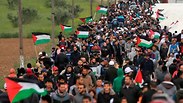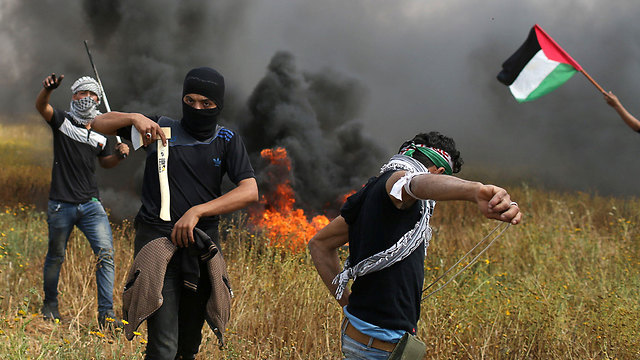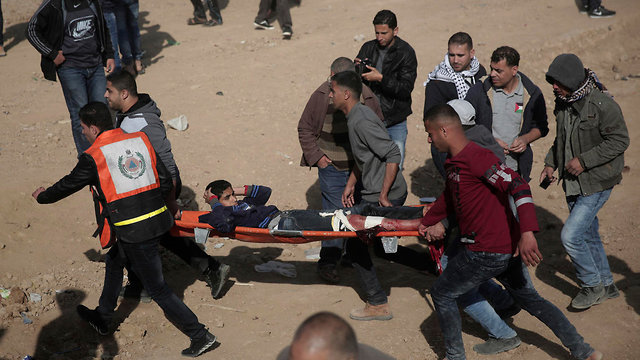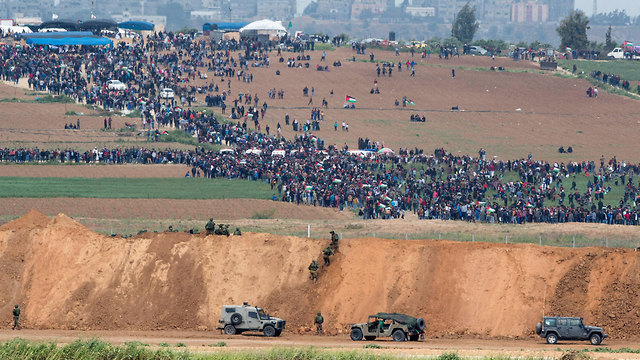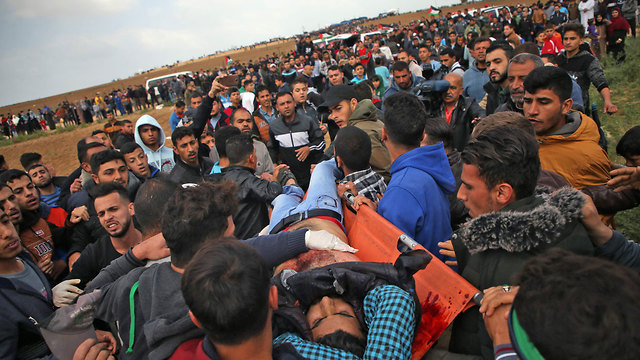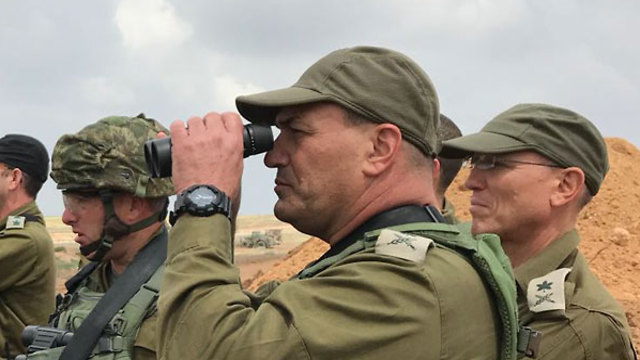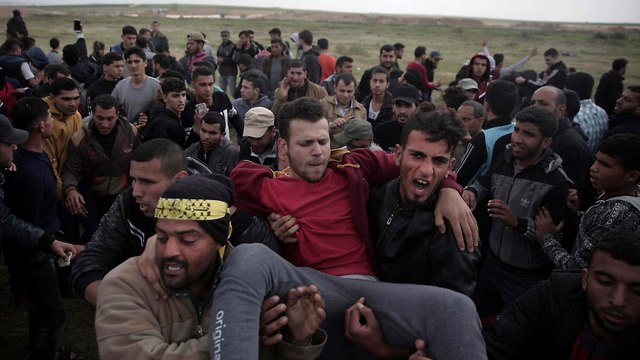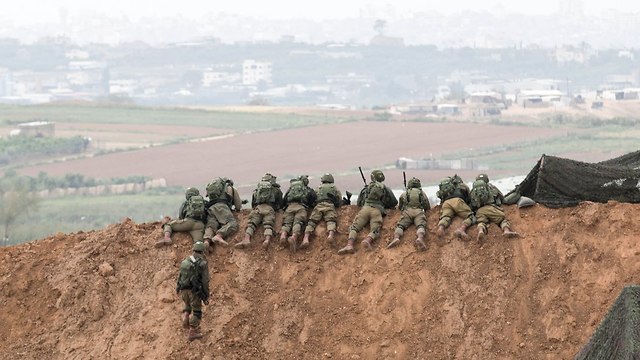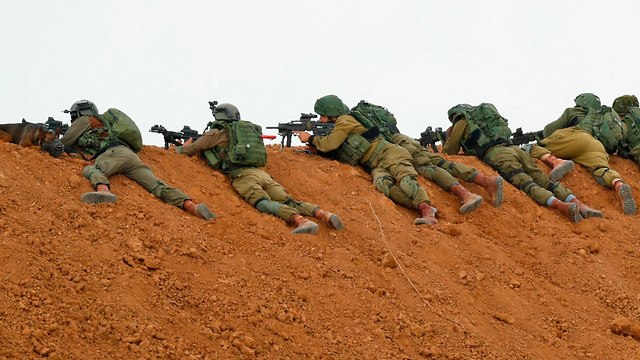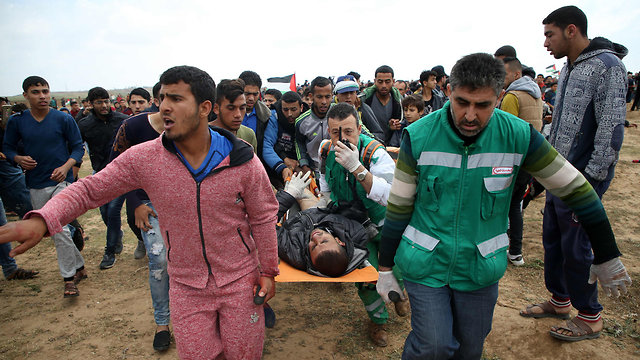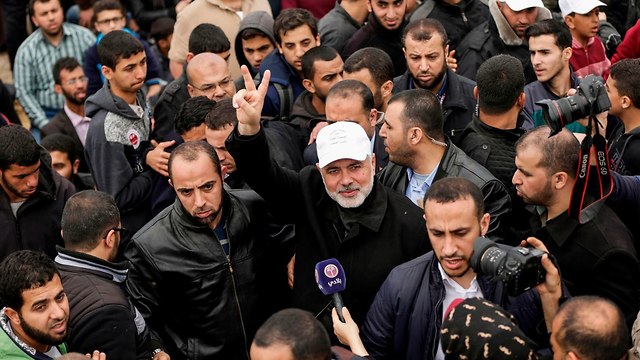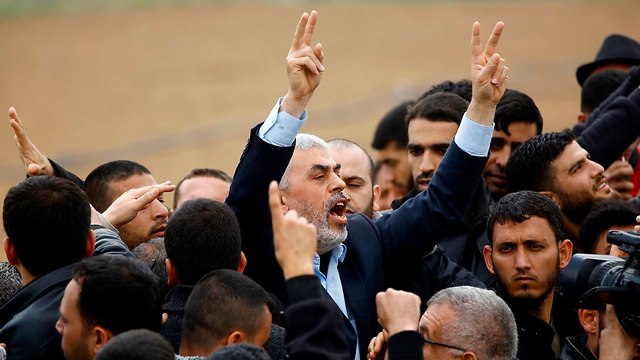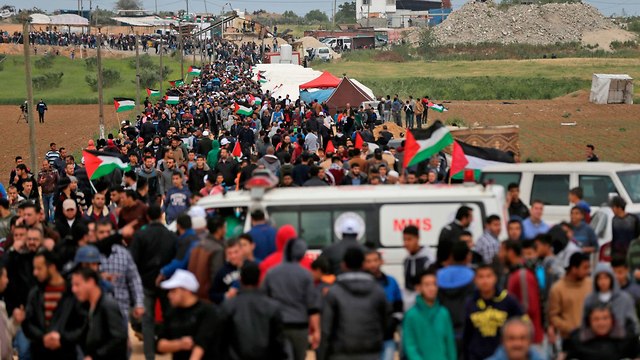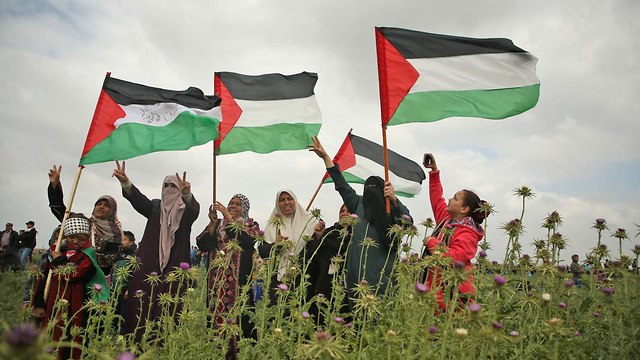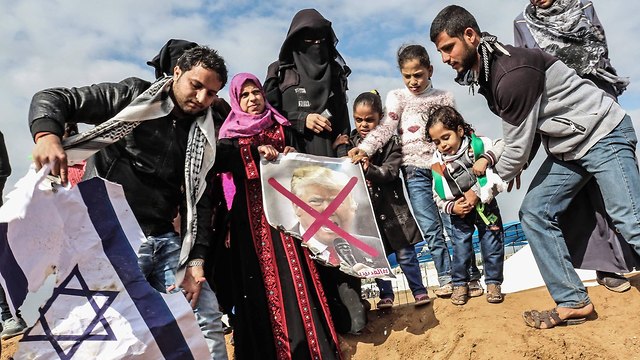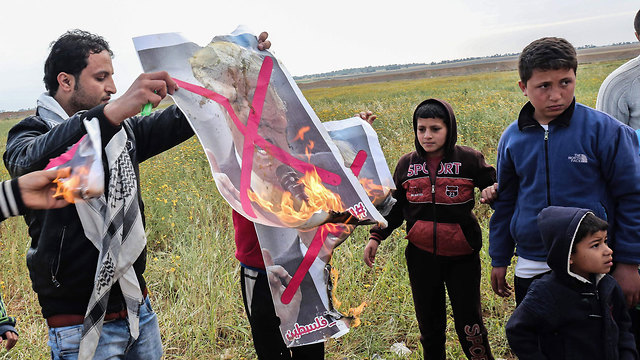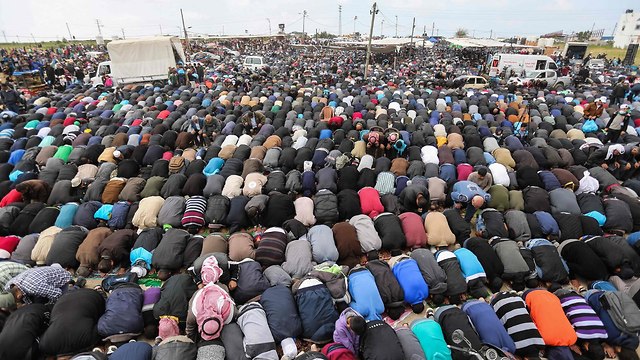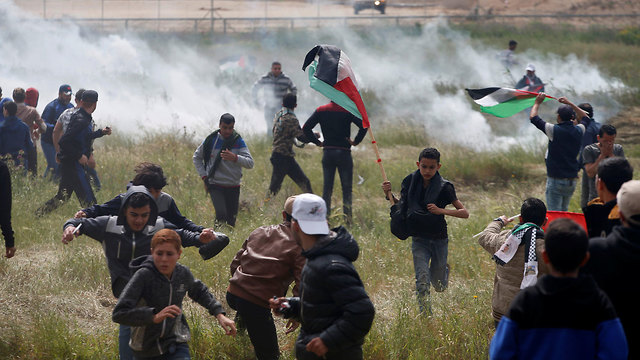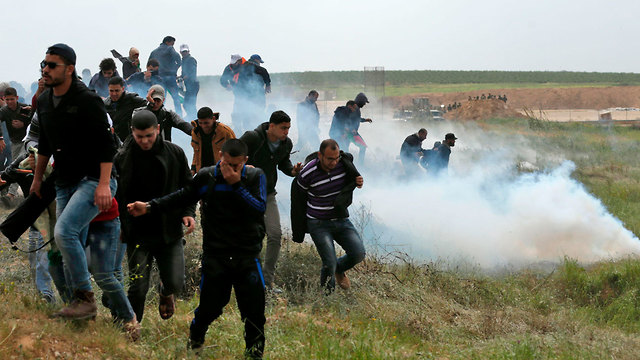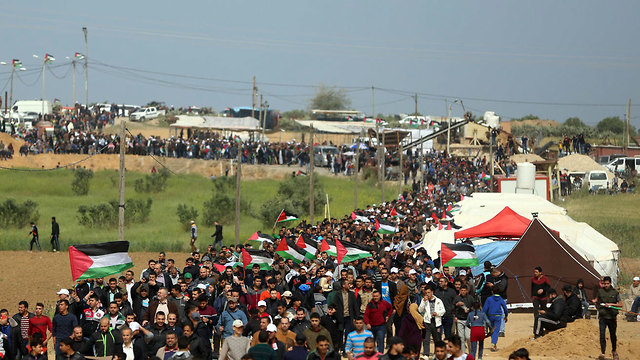
Tens of thousands of Palestinians swarm Gaza border, 16 killed by IDF fire
The 'Great March of Return,' orchestrated by Hamas, draws some 30,000 Palestinians to the Gaza-Israel border; riots ensue, prompting IDF snipers to shoot at main instigators; Defense Minister Lieberman warns anyone who approaches security fence is putting his life in jeopardy; Hamas leader Haniyeh: 'Israel's threats do not scare us.'
At least 16 Palestinians were killed and hundreds more were wounded by IDF gunfire along the Israel-Gaza border, Palestinian sources said Friday, as thousands swarmed the security fence as part of "The Great March of Return," called for by enclave's militant Hamas rulers.
It was the deadliest day in Gaza in several months. Eleven of the Palestinians were killed during the clashes, a farmer was killed by pre-dawn tank fire in a separate incident, and four others from IDF tank fire at an observation post in the northern Gaza Strip.
The IDF said two of the Palestinians killed were members of Hamas's elite Nukhba force. The military also said all of the dead were terror activists aged 18 to 30. According to Palestinian reports, one of those killed was reportedly 16 while another was 33.
Palestinian President Mahmoud Abbas declared Saturday would be a national day of mourning. "Israel is fully responsible for all of the aggression in Gaza today, and fully responsible for the death of Palestinians," Abbas said.
He ordered the Palestinian envoy to the UN, Riyad al-Maliki, to take all immediate steps to demand international protection for the Palestinian people.
The United Nations Security Council was due to meet later on Friday to discuss the situation in Gaza, diplomats said.
The Palestinian Health Ministry said more than 1,400 were hurt in the clashes. The ministry clarified those injured included protesters hit by live bullets and rubber-coated steel pellets, while others were overcome by tear gas.
Palestinian health officials said 758 of the protesters were wounded by live gunfire, while others were struck by rubber bullets or treated for tear gas inhalation. Witnesses said the military had used a drone in at least one location to drop tear gas.
While protest organizers expected some 100,000 Palestinians to join the demonstration, the IDF estimated only about 30,000 showed up.
Organizers invested a lot of resource in free bus services to transport Gazans to the border, the construction of the tent encampments, and an aggressive public campaign among other things, with little results.
In addition, Palestinian witnesses said tens of thousands gathered in tent encampments set up at five sites at a distance of several hundred meters (yards) from the border, but that only some of them engaged in clashes, burning tires and throwing stones at IDF soldiers.
As the protest turned chaotic, the IDF declared the security fence on the Gaza Strip border a closed military zone and began dispersing demonstrators using riot control measures and firing at major instigators with live rounds.
An IDF force caught a seven-year-old Palestinian girl attempting to cross the border fence, and returned her back to her parents in Gaza.
The IDF said that the girl was encouraged to attempt to cross by Hamas, which "endangers women and children and uses them cynically."
GOC Southern Command Maj. Gen. Eyal Zamir said that IDF forces spotted attempts to carry out terrorist attacks, including planting explosive charges on the security fence, under the cover of the mass demonstration. No IDF troops have been hurt in the clashes.
IDF officials estimated early Friday evening the violent clashes on the Gaza border will continue in the coming days, and that even after the great mass of rioters are dispersed, attempts will continue to sabotage the border fence and carry out attacks.
"We didn't allow any crossing of the border fence so far, and no significant damage has been caused to our infrastructure near the fence," said the IDF's Spokesman, Brig. Gen. Ronen Manelis.
"What's been happening since this morning is a violent terror protest. We're still in the midst of the event. So far, we've succeeded in our mission, and anywhere there was an attempt to damage the fence, accurate fire was used with strength, determination and discretion," Manelis added.
"We have information about plans to carry out many terror attacks during the rioting. A significant terror incident will lead to a response by us that will not be limited to the border fence area," the IDF spokesman warned.
The March of Return, Hamas says, is intended to be a weeks-long peaceful demonstration advocating for the return of Palestinian refugees to Israel.
The IDF is on high alert as it sees the march as a hostile attempt by Hamas to sabotage IDF infrastructure and the Gaza security fence, and fear it may lead to a mass breach of the border.
Haniyeh: We will not give up right of return
In the meantime, the Hamas leadership visited the various protest locations: the head of the Hamas political bureau, Ismail Haniyeh, was east of Gaza City; Hamas leader in Gaza Yahya Sinwar was at the southern Gaza Strip; and Gaza Interior Minister Fathi Hamad was at the northern Gaza Strip. They were seen among the crowd, encouraging the people and showing their support.
"This march demonstrates that there are no alternatives to Palestine and the right of return (for the Palestinian people)," Haniyeh told exuberant gatherers, praising their decision to leave their home and attend the protest to "write the future."
Haniyeh then brought to attention the goal of the march, teling attendees it constitutes "the beginning of a return (of the Palestinian people) to the entirety of the land of Palestine."
"We will not give up and we will not bargain with the Zionist entity over even a small piece of the land of Palestine," Haniyeh continued, stressing they will reject any deal proposed by the Trump administration, who he blamed of trampling Palestinian right by "Trump's decision to grant Jerusalem to Israel."
"Israel's threats do not scare us. Our people went out today to make it clear that we will not give up Jerusalem and that there is no alternative to Palestine and the right of return. We will not accept the right of return staying only a slogan," he concluded, telling the crowd, "walk in the path of Allah—you are the victors."
Sinwar, meanwhile, said the protests are a signal to Israel and the world that "our people will not accept the continuation of the siege."
Hamas spokesman Fawzi Barhoum praised the turnout. "The large crowds ... reflect the Palestinian people's determination to achieve the right of return and break the siege and no force can stop this right," he said.
Ahead of the protests, the military said it doubled its standard troop level along the border, deploying snipers, special forces and paramilitary border police units, which specialize in riot control. The army said it would not allow the crowds to breach the fence or damage military infrastructure.
Brig. Gen. Manelis said Israel wants to avoid violence, but warned the IDF will shoot anyone who approaches the border's security fence, enforcing a "no go" zone for Palestinians.
At one of five encampments, east of Gaza City, people clustered around the tents. An unpaved road linking the tents and the border fence was filled with people walking in both directions. People ran for cover from time to time to escape tear gas.
Ghanem Abdelal, 50, distributed water bottles to family members sitting on a mat near one of the tents. He said he hopes the protest "will bring a breakthrough, an improvement, to our life in Gaza."
Families brought their children to camps just a few hundred meters from the border fence, with football fields marked out in the sand, and scout bands playing.
But hundreds of Palestinian youths ignored calls from the organizers and from the IDF to keep away, increasing the risk of confrontation with Israeli troops who had taken up positions on the other side of the fence.
Some of the tents bore names of the refugees' original villages in what is now Israel, written in Arabic and Hebrew alike.
Eighty-year-old Mansi Nassar walked towards the sensitive frontier with the aid of his cane, disregarding entreaties to remain 700 metres (2,300 feet) from the barrier.
"I was born in Beit Darras inside Palestine and I will accept no less than returning to it," he said, referring to his former home village just south of the modern Israeli city of Ashdod. The village no longer exists.
Directly addressing the residents of Gaza in Arabic on twitter, Defense Minister Avigdor Lieberman accused Hamas of "playing" with their citizens' lives, which he warned will be put in danger should they approach the security fence.
الى سكان قطاع غزة :
— אביגדור ליברמן (@AvigdorLiberman) March 30, 2018
قيادة حماس تغامر في حياتكم. كل من يقترب من الجدار يعرض حياته للخطر. انصحكم مواصلة حياتكم العادية والطبيعية وعدم المشاركة في الاستفزاز.
"I suggest that get on with your lives and not participate in the provocation," he wrote, attempting to dissuade them from the protest.
The start of the demonstration was symbolically linked to what Palestinians call "Land Day," which commemorates the six Arab citizens of Israel killed by Israeli security forces in demonstrations in 1976 over land confiscations. The week-long Jewish holiday of Passover, when Israel heightens security, also begins Friday.
Just hours prior to the march, a Gaza man was killed and a second was wounded by an Israeli tank shell after they approached the security fence at the southern part of the strip and "carried out suspicious activity," according to the IDF.
The Gaza health ministry spokesman said the two were farmers. Residents there said they were gathering crops to sell later.
The protest is due to end on May 15, the day Palestinians call the "Nakba" or "Catastrophe," marking the displacement of hundreds of thousands of Palestinians in the conflict surrounding the creation of Israel in 1948.
While Gazans were rallying at the border, dozens of Palestinians commemorating Land Day clashed with IDF forces at the Beit El checkpoint at the entrance to Ramallah and in the Bab a-Zawiya neighborhood of Hebron, burning tires and throwing stones at security forces, which were using riot control measures to disperse them. 65 Palestinians were injured.
Palestinians have long demanded that as many as five million of their compatriots be granted the right to return. Israel rules this out, fearing an influx of Arabs that would eliminate its Jewish majority. Israel argues the refugees should resettle in a future state that the Palestinians seek in West Bank and the Gaza Strip.
Elior Levy, Yoav Zitun, Moran Azulay and Matan Tzuri contributed to this report.
